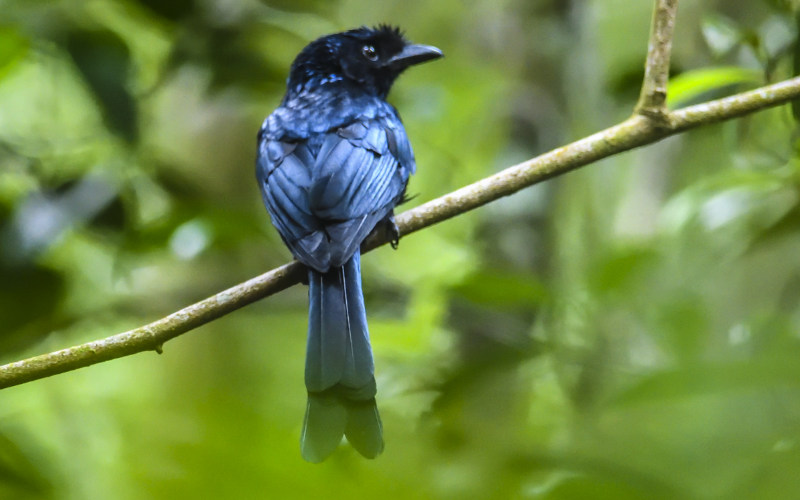Introduction
The Sri Lanka Drongo (Dicrurus lophorinus) or Ceylon Crested Drongo is a bird species in the Dicruridae family. It is only found in Sri Lanka. It was previously thought to be a subspecies of the larger racket-tailed drongo. Its natural habitats are moist lowland and montane forests that are either subtropical or tropical.
Body of Sri Lanka Drongo
The Sri Lanka Drongo is a medium-sized bird, measuring around 30 cm in length and weighing up to 65 grams. The bird’s plumage is predominantly black, with a distinctive forked tail and a white patch on its throat. The bird’s bill and legs are black, and its eyes are a striking bright red. The Sri Lanka Drongo’s unique appearance and acrobatic flight make it a popular bird species for bird watchers and nature enthusiasts.
The Sri Lanka Drongo is found throughout Sri Lanka and parts of southern India, in a wide range of habitats including forests, urban areas, and agricultural land. The bird’s versatility and adaptability make it a successful species in a variety of environments. The bird is primarily insectivorous, feeding on a range of small invertebrates including flies, beetles, and caterpillars. The specification of Sri Lanka Drongo could be summarized as follows;
- Black plumage with metallic blue or greenish-blue gloss
- Arching, helmet-like crest
- Deeply forked tail
- Red-eyes
- Sexes similar
Behaviour of Sri Lanka Drongo
The behavior of the Sri Lanka Drongo is characterized by its acrobatic flight and impressive vocalizations. The bird is known for its high-pitched, metallic calls and its ability to mimic the sounds of other bird species. The Sri Lanka Drongo is also known to engage in “anting,” a behavior in which the bird rubs ants on its feathers to remove parasites and protect itself from infection.
Despite its adaptability and widespread distribution, the Sri Lanka Drongo is still considered to be a species of conservation concern. The bird habitat is under threat from deforestation, urbanization, and agricultural expansion. Efforts are underway to conserve the species through habitat restoration, protected area management, and public education initiatives.

Where Can Find Sri Lanka Drongo
- Bodhinagala Forest Reserve
- The Peak Wilderness Sanctuary
- Morapitiya Forest Reserve
- Sinharaja Rain Forest
- Kanneliya Forest Reserve
- Hiyare Forest Reserve
Conclusion
The Sri Lanka Drongo is a charismatic and versatile bird species that are found throughout Sri Lanka. With its striking black plumage, forked tail, and impressive vocalizations, this bird is a favorite among bird watchers and nature enthusiasts. However, its adaptability and wide range do not guarantee its conservation. The Sri Lanka Drongo’s habitat is under threat from human activities, and conservation efforts are needed to protect this unique bird species. By learning more about Sri Lanka Drongo’s habitat, diet, behavior, and conservation status, we can gain a deeper appreciation for the importance of protecting this charismatic and valuable bird species.



2 thoughts on “Sri Lanka Drongo – A Versatile Bird”
3.5
3.5